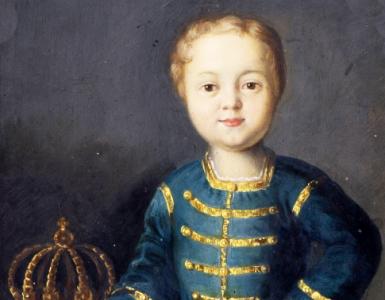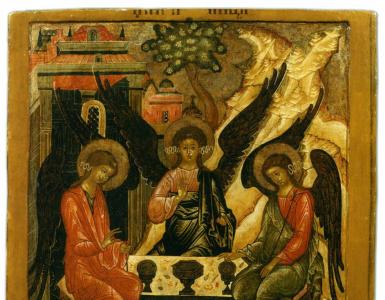Church of St. Sergius in Wrens. Church of St. Sergius in Krapivniki Church in Krapivinsky
The Church of St. Sergius in Krapivniki has been known since the end of the 16th century. It is depicted on the “Peter’s Drawing” of Moscow, and this is so far the only evidence of the existence of a one-domed temple at that time. The first written confirmation of the existence of the church dates back to 1625, when it was wooden.
The name of the church “in Krapivniki” has no clear explanation. According to one version, this could be the name for a sparsely populated area overgrown with weeds and nettles. According to another point of view, the lane in which the church stands was named after the owner of one of the courtyards.
In fact, in 1752, one of the properties next to the temple belonged to the collegiate assessor Alexei Krapivin. In the past there were other names for the church: “in Starye Serebryaniki”, “at Truba”, that is, near Trubnaya Square, “in Storozhi”.
In pre-revolutionary times, the church in Krapivniki was the only church in the center of the capital, the main altar of which was consecrated in honor of St. Sergius of Radonezh.
Sergievskaya Church is small, it stands at an angle to Krapivensky Lane and protrudes far into the roadway with its bell tower. This location tells us about the antiquity of the temple. The oldest part of the church is a small quadrangle, built in stone in 1678. It is surrounded from the north, south and west by later extensions. Only its eastern wall was not built up with anything. Here we can see the altar apse, window casings, and an old cornice. It is not known exactly what the original completion of the cubic building was. Most likely, the church was single-domed.
The southern aisle in the name of the Beheading of John the Baptist was added to the temple in 1702. It is combined with the refectory into a single space. In 1885-1886, the chapel of John the Baptist was enlarged. The apse was rebuilt and moved to the east. It became level with the other two altars of the temple. The Predtechensky chapel became larger in area than the ancient quadrangle and the northern chapel. Now this chapel is dedicated to All Saints who shone in the Russian land.
In 1749, the church was rebuilt, and it became almost the same as we see it today. Above the old quadrangle, a new completion appeared in the form of a rectangular volume with cut corners. On its short sides there were arched niches with keystones. All corners of the superstructure were decorated with pilasters. The new completion of the temple is covered with a high octagonal dome and crowned with a simple, unadorned, smooth drum with a small head and an openwork forged cross. At the same time, the northern Nikolsky chapel was added to the temple (in 1998 it was consecrated in the name of Seraphim of Sarov). The church received features of the Baroque style. It is possible that the reconstruction of the temple was carried out according to the design of the master of the school, Prince D.V. Ukhtomsky, the chief architect of Moscow in the mid-18th century.
The famous Russian philosopher, public figure, writer and music critic V.F. was baptized in the Sergius Church. Odoevsky (1804-1869). In 1812, during the stay of Napoleonic army in Moscow, the church was badly damaged. After the French left, it was assigned to the neighboring Church of St. John the Evangelist (not preserved, stood in Petrovsky Lane). Worship services were resumed only in 1875.
On November 15, 1883, the Sergius Church, which did not have its own parish, was transferred to the Patriarchate of Constantinople for the establishment of its own metochion (representative office in the Russian Empire).
In 1920, the Church of St. Sergius in Krapivniki largely shared the fate of the entire Russian Orthodox Church. Valuables were forcibly confiscated from it (liturgical vessels, ancient vestments on icons and the icons themselves). It is known that the seizure of valuables was accompanied by unrest among parishioners. In 1934, the last Greek abbot of the temple dies. Due to the fact that, from a formal point of view, the Constantinople courtyard did not belong to the Russian Church, it was not closed for several more years. The temple was one of the last to be closed in Moscow - in 1938. At the end of the 1930s, the ringing tier of the bell tower and the drum above the main volume of the now closed church were dismantled. Inside, a handicraft industry for sharpening skates was set up, which is explained by the proximity of the Dynamo skating rink, beloved by Muscovites. The temple remained in this form until August 30, 1991, when it was consecrated by Patriarch Alexy II. Now the temple is the Patriarchal Metochion.
In 2001, the bell tower, dismantled by the Bolsheviks, was restored, and in 2010, the chapel was consecrated in honor of All Saints who shone in the Russian land. In 2013, the painting of the Seraphim chapel, made by icon painter Irina Zaron, was unveiled.
On the outer northern wall of the temple there are boards with inscriptions in beautiful script, telling about the parishioners buried next to them. Several representatives of the Ukhtomsky princely family are buried here. They lived in Sergius parish in the 16th-18th centuries. Here were the graves of Princess E.M. Dashkova (1711), steward M.B. Chelishchev and his wife and others. To this day, under the southwestern corner of the refectory, the tomb of the Ukhtomsky princes remains. The necropolis of the Sergius Church is one of the most famous in Moscow
Since 1991, the Church of Sergius has housed an outstanding work of art and a revered shrine - the Kiy Cross, one of the most significant reliquaries in the history of Christianity. The cross, repeating the dimensions of the Cross of Christ, was made by order of Patriarch Nikon and consecrated on August 1, 1656 in Moscow. It was intended for the Cross Monastery founded by Nikon on Kiy Island in the White Sea. Patriarch Nikon placed in the Cross particles of the relics of 104 saints and 16 stones from various holy places in Palestine. The cross was in its place, in the Cathedral of the Cross Monastery, until 1923. Then it was transported to the anti-religious museum on Solovki, and in 1930 to the State Historical Museum in Moscow. Among other revered shrines of this ancient temple are miraculous icons: the image of the Mother of God of Feodorovskaya and the image of St. Sergius of Radonezh.
What is what in the churchAlso here could be a settlement of wrens who were engaged in the preparation of nettles. In the old days, it was finely chopped, mixed with flour and fed to horses and pigs. And cabbage soup was made from young nettles.
In 1625, the Church of Sergius of Radonezh appeared in Krapivniki. In 1678, a pillarless building was built on the site of a burnt wooden church, and in 1749 it was rebuilt, a second tier was added and a bell tower was erected. Around the same time, the refectory and chapel of John the Baptist appeared. The project for rebuilding the temple was presumably prepared by an architect from the team of D.V. Ukhtomsky.
In 1883, the Church of St. Sergius of Radonezh in Krapivniki, which did not have its own parish, was transferred to the Patriarchal Metochion of Constantinople, and a complex of three-story buildings designed by S.K. Rodionova. The facade was decorated with Byzantine, Old Russian and Muslim ornaments. So the architect wanted to show that the ancient Patriarchate is located in a Muslim country, but the courtyard is on Russian soil. For a long time the temple was also the tomb of the Ukhtomskys.
In 1938, the church in Krapivniki and the courtyard were closed, and the bell tower was partially dismantled. Skate production was set up inside, since the Petrovsky skating rink was nearby.
Guide to Architectural StylesIn 1991, the temple was returned to the Russian Orthodox Church. Now its most famous shrine is the Kiy Cross with the relics of 400 saints, although some of them have been lost. It was made for the Kiysk Monastery in memory of the miraculous rescue of Patriarch Nikon from a storm on the White Sea. Cypress was brought from Jerusalem especially for this cross. The size of the shrine exactly repeats the cross on which Jesus Christ was crucified. The cross was covered with silver sheets, and particles of the Lord's cross and parts of Christ's robe were placed inside. It was decorated with 15 gilded stars with particles of the Holy Sepulcher, parts of the Nativity scene stone and parts of the coffin of the Virgin Mary. On the front side of the cross there are the relics of 97 saints with signatures, and on the back there are the relics of another 300 saints without signatures.
In the 1930s, the Kiy cross was in the anti-religious museum on Solovki, then it was kept in the storerooms of the State Historical Museum. In 1991, the shrine was transferred to the Church of St. Sergius of Radonezh in Krapivniki.













